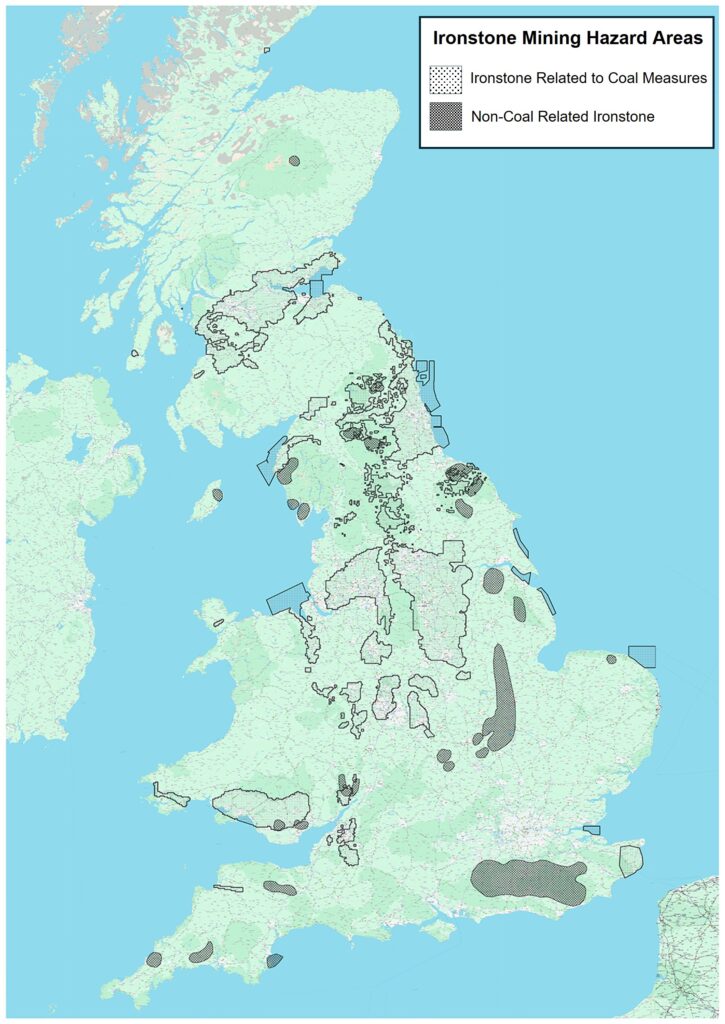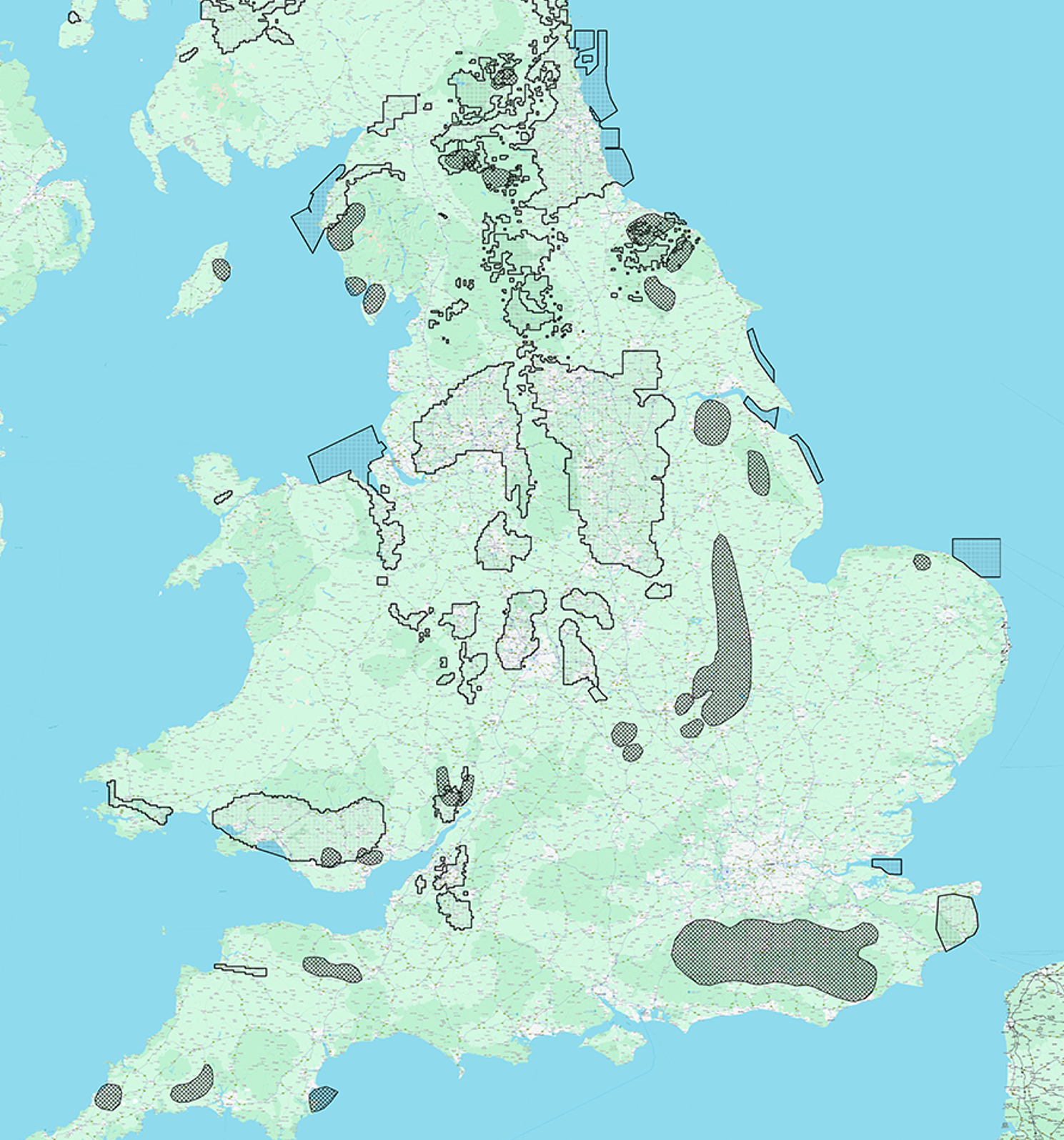Ironstone is a sedimentary rock, primarily deposited in oceanic environments, that contains a higher-than-average iron content resulting from either its original depositional setting or through subsequent chemical replacement.
Iron is extracted from the ironstone by crushing and grinding, with the enriched ironstone pellets then fed into a blast furnace along with a reducing agent (usually coke) and a flux (usually limestone) to remove impurities. In the brief description of the process, it can be seen why having either a local supply of coal or limestone would be advantageous.
Iron has been used in the manufacture of tools, weapons, pots and pans, jewellery and ornamental decoration for over 3000 years; however, as with most mined minerals significant extraction did not begin until the start of the Industrial Revolution.
Ironstone Geology and Key Mining Regions
There have been three main periods during the geological history of the UK that have resulted in the formation of ironstone. These are:
- Carboniferous (c. 360 to 300 million years ago), in close association with the Coal Measures.
- Jurassic Lias Group (c. 200 to 175 million years ago), including Cleveland Ironstone Formation, Northampton Sand Formation, Frodingham Ironstone Member, and the Marlstone Rock Formation.
- Cretaceous Claxby Ironstone and Wealden Ironstone (c. 145 to 120 million years ago).
The map below (compiled from British Geological Survey & Coal Authority data) shows the areas of the UK that are classed as having legacy ironstone mining hazards related to the Carboniferous Coal Measures (lighter hatch) and the Jurassic / Cretaceous ironstone formations (darker hatch).

The mining of Carboniferous ironstone took place in close association with the coalfields of South Wales, Midlands, Lancashire, Scotland and Yorkshire.
The Jurassic Lias Group ironstone outcrops as a continuous band running NE/SW from North Yorkshire & Cleveland down to the coast of Devon. The key mining areas included:
- Cleveland (North Yorkshire) – Mining the Cleveland Ironstone
- Lincolnshire – Mining the Frodingham Ironstone Member, which is part of the broader Lincolnshire Limestone Formation, Marlstone Rock and Northampton Sand Formation
- Northamptonshire – Mining the Northampton Sand Formation
- Oxfordshire – Mining the Marlstone Rock Formation
The Cretaceous Claxby Ironstone and Wealden Ironstone are found and were mined in East Sussex and Kent, primarily during the Roman era.
Ironstone Mining
Various methods have been used to mine and extract ironstone through the ages, and these are summarised below along with the areas of the country where each type of mining was prevalent.
- Adit and Drift Mining: Horizontal passages driven into a hillside was a common method of mining in the Cleveland Hill and surrounding area. The Northampton Sand was also mined using adits and sometimes at the bottom of Limestone quarries in Lincolnshire. Claxton Ironstone, also in Lincolnshire was also predominantly mined by using adits.
- Opencast Mining: Opencast mining for ironstone has been the predominant method for extracting the Northampton Sand in Lincolnshire, Northamptonshire and Oxfordshire, although near surface deposits of the Cleveland Ironstone were also locally mined in this way. Ironstone associated with Coal measures was also mined using this method where it was present in opencast coal mines.
- Shaft Mining: This was the predominant method of ironstone mining from Coal Measures in the Victorian era, but the Cleveland Ironstone and Northampton Sand were also locally mined from shafts
- Coastal Mining: This method of mining was used in and around Sandsend, Goldsborough, Staithes, Loftus and Kettleness along the coast of North Yorkshire where it was mined from the beaches and cliffs and transported by sea to nearby ironworks.
Risks to Developers and Landowners
The risks posed by historic ironstone mining are similar to those for coal mining and include:
- Land Subsidence: The collapse of old mine workings and entries can cause ground subsidence, damaging buildings and infrastructure.
- Land Settlement: Where development are proposed over former opencast sites which have been backfilled, there can be issues associated with settlement of buildings and infrastructure, especially if they are built over the high wall.
- Gas Emission: Abandoned mines and mine entries can release methane and other gases, posing explosion or health risks if they remain unflooded where ironstone was extracted in combination with coal.
- Radon: Due to high levels of phosphorus and uranium a high proportion of houses underlain by ironstones are recorded to have radon levels above the UK Action Level of 200 Bq m-3.
- Contamination: Jurassic Ironstones are also recorded to contain naturally elevated concentrations of arsenic and vanadium. Colliery spoil can contain contaminants such as heavy metals and hydrocarbons. Acid Mine Drainage can also pose a risk to controlled waters.
If you have any development or construction projects that may be impacted by historical mining workings and hazards, then please get in touch to find out how we can help save both time and costs. Please use your main point of contact at GRM or for new enquiries email richard.upton@grm-uk.com or call 01283 551249.


